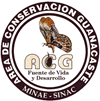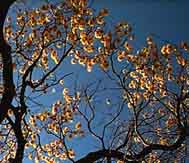
Tabebuia ochracea
(A. Gentry) A. Gentry
Corteza amarilla
(Bignoniaceae)
 |
Tabebuia ochracea (A. Gentry) A. Gentry Corteza amarilla (Bignoniaceae) | |
Sullivan, J. J., Masís, A. , Chavarría, F., Espinoza, R., Guadamuz, A. y Perez, D. 1998. Species Page de Tabebuia ochracea (Bignoniaceae), 30 Setiembre 1998. Species Home Pages, Area de Conservación Guanacaste, Costa Rica. http://www.acguanacaste.ac.cr
Trees of up to 25-30 m in height (the height of a mature dry forest canopy) and approximately 50 cm DBH (Diameter at Breast Height).
Other common names: "Cortez amarillo", or simply "cortez" or "corteza". People use these names to also refer to the other species of Tabebuia in Costa Rica that produce yellow flowers (T. guayacan and T. chrysantha). The name "guayacán" can also be applied to T. ochracea (as well as T. guayacan and T. chrysantha), although they should not be confused with the real "guayacán", Guaiacum sanctum (Zygophyllaceae). The name "guayacán" is applied to T. ochracea because, like G. sanctum, T. ochracea has extremely hard wood.
Flowers:
Tabebuia ochracea is famous throughout Central America for its brief, spectacular displays of large yellow flowers in the dry season. These displays last only 4-5 days and are synchronized across the trees of large areas of forest and agroscape (see Natural History notes for more details).
Each flower is approximately 8 cm long, and part of a terminal inflorescence (i.e., at the tip of a branch). The flowers are perfect and zygomorphic, i.e, each flower has both male and female sex organs, and it has only one plane of symmetry. One flower lasts only one day, and an inflorescence in total lasts only 4-5 days.

Fruit and seeds:
T. ochracea fruit are 20-40 cm long pods, with the two outer walls covered in dense pale brown hairs. Inside a fruit pod are two hemispheres of tightly packed seeds separated by a central woody wall. When a fruit pod is mature and dry, the two outer walls separate to release a large number of small, white, laterally-winged seeds (15-25 mm long). It is possible for fertilized flowers to develop into completely mature fruit, dispersing their seeds, within 3 weeks. The seeds normally disperse in the last weeks of the dry season and the first weeks of the wet season (between late April to early June, with the exact weeks of dispersal varying year to year).
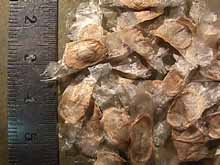
Leaves:
T. ochracea leaves are palmately compound, each of the 5 leaflets emerging from a central point at the end of the petiole (see photos below). Leaves are oppositely arranged, occurring in pairs along a shoot. The leaves of mature trees are characterized by dense white pubescence on the undersides of leaves. This is especially evident in T. ochracea trees of dry forests, although less evident in trees of wetter forests. No other tree species in the dry forests of the ACG has palmately compound leaves with pubescent white undersides.
There are marked differences between the leaves of mature trees of the forest canopy and the leaves of understory saplings. Relative to the leaves of mature trees, sapling leaves have browner hairs at much, much lower densities (see photos below). Saplings leaves are also much larger than tree leaves, with most sapling leaves 35-55 cm long while with most tree leaves are 25-35 cm long. The leaflets of sapling leaves occasionally have serrations on their margins, a trait absent from tree leaves.
The leaves of seedlings and very young saplings (plants less than 50 cm high) are often simple or palmately compound with 3 leaflets.
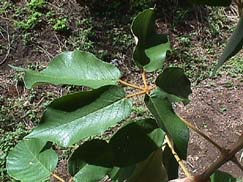
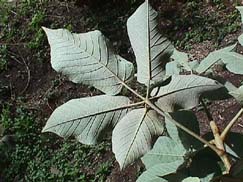
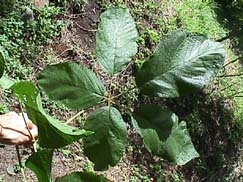
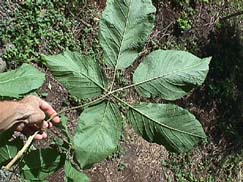
[Note that these photos are not at the same scale. The sapling leaf is much larger than the tree leaf- see text.]
Bark and wood:
T. ochracea bark is light grey with thin shallow longitudinal fissures. The tissue below the old bark of tree limbs can be bright yellow in color. This coloration is most likely the origin of this tree species' common name, corteza amarilla (literally, "yellow bark").
There is a marked color difference between the sapwood and the heartwood of T. ochracea wood, the outer sapwood being light tan to light grey while the heartwood is a rich red brown. When first cut, the wood is covered in a yellow powdery substance called "lapachol" which is released from the broken vessels. This sulfur yellow powder turns deep red in the presence of alkaline solutions (Record and Hess 1940). The "lapacho group" is a term that foresters apply to the woods of many different Tabebuia species throughtout latin america that produce the lapachol substance when cut, including T. ochracea.


Whole plant:
T. ochracea trees throughout most of Guanacaste are charcterized by contorted trunks, as juvenile trees are especially adept at growing towards wherever there is most light and are also commonly attacked by the tabebuia shoot borer. This characteristic of contorted tree trunks is much less evident in old growth forests where the trunks of T. ochracea trees can be very straight (light sources for young trees are more vertical in old growth forests, and infestation by the tabebuia shoot borer is also less common).
The architecture of young Tabebuia rosea saplings is described in detail by Borchert and Tomlinson (1984) and Borchert and Honda (1984), and T. ochracea sapling architecture is comparable (Borchert and Tomlinson 1984, personal observation). Like T. rosea, undamaged Tabebuia saplings are characterized by a leader branch with a vigorously growing shoot, and successive pairs of lateral branch complexes with many less vigorously growing shoots. Wild saplings growing in the dry forests of the ACG are hardly ever as clean as the architectural model that Borchert and Tomlinson (1984) and Borchert and Honda (1984) describe, as the vigorously growing shoots of these leader branches are highly prone to tabebuia shoot borer damage, and infestation over successive years quickly complicates the architecture of the sapling apex.
Similar species:
T. ochracea is the most common species of Tabebuia in the dry forests of the Area de Conservación Guanacaste. Two other species of Tabebuia are also commonly encountered in these dry forests, T. rosea and T. impetiginosa. In the ACG dry forests, only these three Tabebuia species have oppositely arranged palmately compound leaves with five leaflets (all of the other species with palmately compound leaves with five leaflets have their leaves arranged alternately). T. ochracea trees are easily distinguished from T. rosea and T. impetiginosa trees by the distinctive pubescent white undersides of T. ochracea leaves. The leaves of T. rosea and T. impetiginosa trees lack obvious pubescence. Saplings of T. ochracea, with their larger, less pubescence leaves, can still be easily be distinguished from saplings of T. rosea and T. impetiginosa by the obviously pubescent brown shoot walls of T. ochracea saplings. Like their tree leaves, the leaves and shoots of T. rosea and T. impetiginosa saplings are largely hairless. Of the dry forest Tabebuia species, only T. ochracea has yellow flowers.
[Note: T. rosea can be distinguished from T. impetiginosa by T. rosea's much thicker, tougher leaves and by the astringent smell of crushed T. impetoginosa leaves that T. rosea (and T. ochracea) lack.]
T. ochracea also exists in the wetter forests of the ACG such as in sectors Orosi and Cerro El Hacha. Two other species of Tabebuia also occur in the wet forests of Costa Rica, T. chrysantha and T. guayacan both of which also produce spectacular, synchronized displays of yellow flowers. T. guayacan has been recently identified in the ACG, and it is possible that T. chrysantha also occurs there. When moving into progressively wetter forests, the leaves of T. ochracea trees and saplings become less pubescent than their dry forest relatives, and it becomes possible to confuse T. ochracea with T. chrysantha. T. chrysantha has less dense pubescence than T. ochracea and can have some leaves with 7 leaflets (Quesada Quesada et al. 1997). Unlike the above species, T. guayacan leaves lack all pubescence except on the leaf axil (with stellate trichomes) (Gentry 1980).
Nomenclature:
Tabebuia ochracea Standl. ssp. neochrysantha (A. Gentry) A. Gentry
Synonym: This species was previously named Tabebuia neochrysantha A. Gentry.
International:
The species Tabebuia ochracea occurs naturally throughout most of latin america, from Honduras in the north to Brazil in the south (Gentry 1992). The central american subspecies T. ochracea neochrysantha that occurs in the ACG ranges from Honduras and El Salvador to Venezuela and Trinidad, and occurs in tropical dry forests through to the drier parts of tropical moist forests, from 0-1000 m in altitude (Gentry 1992).
In Costa Rica:
T. ochracea is common in the drier forests throughout Costa Rica, especially in the Guanacaste province. It is also common to see trees of T. ochracea throughout the urban and agricultural areas of Costa Rica, again especially in Guanacaste.
In the Area de Conservación Guanacaste:
T. ochracea can be found througout all of the drier forests of the ACG, occuring in parts of all of the conservation area's sectors. It does not occur in the cloud forests of Cacao, Orosi, and Rincon de la Vieja, but it does occur on the drier western slopes of Rincon de la Vieja (Sector Pailas) to an altitude of at least 900 m. The species occurs in the highest densities in lowland dry forests. For example, in 1996 a 35 hectare plot of 70-80 year old dry forest in Sector Santa Rosa (called Bosque San Emilio), there were 495 T. ochracea trees greater than 3 cm DBH (Brian J. Enquist, unpublished data).
Mapa de macro-habitats del ACG |
Summary of phenology:
DRY SEASON (late December to early May):
Trees leafless throughout the deciduous dry forest. Some plants in wetter forests and patches of evergreen old growth dry forest can maintain their leaves, but no growth occurs.
One or more mass flowering events occur mid- to late-dry season, cued by infrequent dry season cold fronts or rain spells.
Fruit pods develop to maturity in about three weeks following a flowering event.
Thousands of tiny winged seeds are released late dry season or early wet season, forming highly leptokurtic seed shadows about each parent tree.
WET SEASON (late May to early December):
Leafless trees produce new shoots and expand new leaves. Most of the year's shoot expansion occurs during the first few weeks of the wet season.
Also with in the first few weeks of the wet season, all viable seeds germinate, producing a short lived carpet of seedlings. Most soon die.
Within a month or two, tree shoot growth is terminated by apical flower primordia, which lie dormant until the following dry season.
Throughout the rest of the wet season, saplings and adult trees photosynthesize but rarely produce more leaves. There can be a short additional burst of growth in some saplings following the end of the "little dry season" in late August.
Life and death of seedlings:
All viable T. ochracea seeds germinate in the first month of the wet season. No further germination occurs later in the season or the following year.
The great majority of these seedlings do not survive the wet season, most of the surviving seedlings do not survive their first dry season, and the growth rates of the few seedlings that survive to one year old are mostly very slow. For example, in July 1995, the positions of 272 first year seedlings were mapped within 40 m of a parent tree in a 30 year old patch of Santa Rosa dry forest. Of these, only 31% survived to the end of August 1995, and 3% survived through the dry season to the beginning of June 1996. By 1997, all were dead. Growth rates of those seedlings that survive their first years are also extremely low. In July 1995, heights were recorded for 41 non-first year seedlings <= 20 cm high in the same patch forest. Most of the seedlings were in light shade, and some below small canopy light gaps. Despite this, when they re-measured in July 1996, it was found that these plants increased in mean size from 9.9 cm (s = 3.9) to only 10.3 cm (s = 3.3), with the fastest growing individual moving from 15 cm to 20 cm (J. J. Sullivan, unpublished data). The inevitable conclusion is that the great majority of wild seedlings grow extremely slowly.
These observations contrast dramatically with the growth rates possible in managed propagation that have been demonstrated at the Horizontes Experimental Forestry station of the ACG. Seeds that are collected from trees in January and February, sun dried, and potted with adequate water in light shade and with added fertilizer and fungicide are about 40 cm high by June and ready to plant out into the field (F. Méndez Miranda, personal communication). Four year old plants in an open plantation are 1.5 m to 2 m high with many shoots.
Growth of saplings:
Foliage and shoot growth on dry forest saplings flushes out following the onset of the rains in early May, with saplings leafing out over a week before mature trees (Reich and Borchert 1982). Sapling shoot growth is almost entirely largely restricted to the first month after the beginning of the rains, although a second flush of growth occurs in some saplings when the "little dry season" ends in August. In November-December at the onset of the dry season saplings shed their leaves (although in wetter forest and old growth dry forest this is not always the case).
T. ochracea is a shade-tolerant species requiring canopy gaps for growth, like the related T. rosea (Brokaw 1980 (cited in Coley 1983), Welden et al. 1991). The abundance of T. ochracea saplings of various heights in the understory of Santa Rosa dry forests testifies to their ability to survive for many years in the shade of secondary growth forests. However to grow in height enough to reach the canopy, saplings need to be in canopy gaps left by fallen trees. This is well illustrated by the vertical growth rates of a 1997 sample of 82 saplings between 0.5-6 m in initial height in an area of 70-80 year old dry forest in Sector Santa Rosa, half of which were located in the centers of treefall light gaps and half in neighboring understory shade . The shaded saplings grew on average only 3.2 cm in height (stdev = 9.1, max. = 25 cm) while the saplings in the light grew on average 26.6 cm in height (stdev = 29.5, max. = 109 cm). That initially taller saplings did not grow in height significantly more than the smaller saplings.
At these average 1997 growth rates, a 1 meter high saplings in a light gap will need 107 years to reach a 30 m high dry forest canopy, while a shaded sapling will require 800 years (such a shaded sapling will be squashed by a falling branch well before it ever lives this long). This is obviously a rough calculation, but it well illustrates the importance of canopy gaps for the regeneration of T. ochracea.
Growth, flowering, and death of adult trees:
At the beginning of the wet season, adult trees grow shoots and from the two opposite lateral buds that were below the apices of the dry season's inflorescences and infructescences. This growth elongation halts 1-2 months into the wet season when the apical meristem is terminated by the formation of apical flower primordia (Reich and Borchert 1982). These densely hairy flower primordia remain dormant until the middle of the dry season of the following year. During the dry season months adult trees are leafless. Flowering occurs synchronously across the population, cued by infrequent dry season cold fronts or rain spells.
The opening of flowers is synchronized both at the individual and population scales. All of the inflorescences in the canopy of a tree open their first flowers at the same time, 6-7 days after a day of unseasonable rain or cold air in the dry season. Flowers open at this time for most of the reproductively mature trees in the area affected by the unseasonal weather. Thousands of T. ochracea trees in a large portion of the Guanacaste province can be ablaze with brilliant yellow for the same one 4-5 day period. In the dry season of some years there is more than one flowering event, and a single tree can produce a flower crop in more than one of these flowering events.
It is often claimed that T. ochracea trees need a rain shower in the dry season to initiate their flowering. Although flowering episodes do often follow an unseasonal dry season cloudburst, this is not always the case. For example, in the 1997 dry season in Sector Santa Rosa, the April mass flowering event followed a period of cold nights when no rain fell (see graph). Apparently the trees use unseasonally cold temperatures in the dry season to cue the synchronous opening of their flowers, whether there is associated rain or not. They do not require a new supply of water to expand their flowers.
No self-fertilization of flowers occur within a tree canopy, with flowers demonstrating late-acting incompatibility (Gibbs and Bianchi 1993).
Trees of T. ochracea are regularly more than 100 years old. Tree deaths are infrequent and are due to a variety of causes. Of those fresh tree corpses known in Sector Santa Rosa, one had been killed by a lightning strike, two were growing in very shallow soils and had been toppled over by the wind, one had such an unbalanced trunk that it's canopy had snapped off, and another had its base rotted out by fungus which had entered through an old fire scar at the base of the tree.
Flower pollinators and nectar robbers:
Many different kinds of bees, flies, butterflies, wasps, and hummingbirds can be observed visiting T. ochracea flowers. They are pollinated by a variety of bees, especially euglossines and anthophorids, and the nectar is commonly robbed by hummingbirds and xylocopid bees (Gentry 1983).
Herbivores, seed predators, and pathogens (see also the Tabebeuia ochracea insect herbivore list):
T. ochracea flowers are fed upon by a variety of canopy dwelling vertebrates, including spider monkeys (Ateles geoffroyi, Cebidae), howler monkeys (Alouatta palliata, Cebidae), varigated squirrels (Sciurus variegatoides, Sciuridae), and ctenosaur lizards (Ctenosaura similis, Iguanidae). These flowers may be a valuable source of water at the end of the dry season for these animals. Fallen flowers are commonly collected by leaf-cutter ants (Atta cephalotus, Formicidae).
Developing T. ochracea fruits are fed upon by white-faced monkeys (Cebus capuchinus, Cebidae) which rub off the hairs, open up fruits and eat out the young seeds (Lisa Rose and Katherine MacKinnon, personal communication). The developing seeds are also fed upon by a species of caterpillar (Pyralidae), which mine through the seeds. The caterpillars can destroy the great majority of the developing seeds in heavily infested fruit pods.
Above ground vegetative tissues of T. ochracea in Santa Rosa are fed on by at least XX species of insect but no vertebrates (for more details, see Tabebuia ochracea insect herbivore list). Most of these insect species feed on fully expanded leaves of understory plants (personal observation). Shoots are destroyed by the tabebuia shoot borer (Lepidoptera: Pyralidae). A coreid and a pentatomid bug both suck from the vascular tissue of young growing shoots, and the scarabid beetle Euphoria limatula scrapes notches out of the sides of young shoots at the beginning of the wet season. Monochroa sigimarini caterpillars (Lepidoptera: Gelechiidae) feed on the expanding young leaves (occasionally also damaging the shoot tip), as do a species of unidentified fly larva whose feeding distorts leaf development. Young seedlings have small, simple or trifoliate leaves that are ignored by most of the T. ochracea herbivores, although early instar larvae of Ecpatheria icasia (Lepidoptera: Arctiidae) have been observed feeding on small seedlings, and leaf cutter ants (Atta cephalotus, Formicidae) often remove a large proportion of the cotyledons of newly germinated seeds. In the adult crown I have observed Monochroa larvae (when new leaves flush at the beginning of the wet season), Euphoria limatula, the chrysomelid alticin beetle Megistops nr. costaricensis, and infrequently the tabebuia shoot borer.
Bark:
The anti-cancer properties of bark extracts from several Brazilian Tabebuia species, including Tabebuia impetiginosa, have produced much interest in the bark chemistry of the genus both among biochemists (e.g., Kang et al. 1990, Blatt et al. 1996, Pinto et al. 1997) and the alternative medicine industry (e.g., see http://alternativemedicine.com/issue7/pharm.html), and includes T. ochracea (e.g., Zani et al. 1991). In the Andes, the inner bark of T. impetiginosa is traditionally scraped and made into a tea with reported medicinal propertes, and the American Health and Herbs company which now sells T. impetiginosa at $13.10 for 2 OZ. claims that the extract can be used for everything from skin sores and warts to asthma to arthritis to snake bites to killing viruses (including AIDS!) (http://www.cyberline.com/herbs/singles.htm, 1996). Drink with a grain of salt!
Wood:
The lapacho Tabebuia woods, including T. ochracea, are renowned for their exceptional strength and durability, being perhaps the hardest, heaviest, most durable woods of any group of neotropical trees (Gentry 1980). The heartwood is very reistant to attack by fungi and termites (Chudnoff 1984). The classic example of this are beams of T. guayacan, another lapacho Tabebuia, that were used to build the cathedral of Old Panama city and are still perfectly sound after exposure to weather since the destruction of the city over 300 years ago (Record and Hess 1940).
These hard, heavy, and durable qualities make lapcho Tabebuia woods valuable for many uses. The woods are especially used for the construction of outdoor furniture, railroad crossties, heavy construction, tool handles, industrial flooring, etc. (Chudnoff 1984, San Román et al. 1981, Carpio Malavassi 1995). Tabebuia wood of the lapacho group (which also commercially goes by the name "ipe") was one of the main timbers used by outdoor furniture manufacturers in the USA (now mostly replaced by plantation teak), and is now used in the US for flooring (and is apparently specified for US Army truck beds) (John Curtis, personal communication). In Costa Rica, these woods were traditionally used to make the parts of ox-pulled carts, and are now one of the woods favored for the beds of converted pickup trucks. The abrupt difference in color between the sapwood and heartwood, combined with the wood's "magnificent finish" (San Román et al. 1981) also make it useful for furniture, household objects, tourist gift items, and decorative veneers (Gentry 1980, Chudnoff, 1984). The timber is further useful as a pulp for paper (Carpio Malavassi 1995, San Román et al. 1981).
T. ochracea is one of numerous native Costa Rican trees being screened by the Horizontes Experimental Forestry Station of the ACG for potential use in reforestation and plantation forestry projects. Despite having "one of the finest woods in Costa Rica" (Nichols et al. 1991 p. 21, translated), the development of T. ochracea as a high quality timber species is largely prevented by its very slow growth and often twisted form when growing in pastures and young forests (Nichols et al. 1991, Edgar Viquez (MACORI, Liberia), personal communication).
Whole plant:
T. ochracea trees are highly valued as ornamentals due to their spectacular dry season shows of flowers, and can commonly be found planted in towns and cities, within and along the borders of farms, and occasionally for use as living fence posts. Seeds of T. ochracea can even be purchased in San Jose tourist gift stores (under the name "Golden Goddess").
Tabebuia ochracea is a common tree of the deciduous dry forests of Sector Santa Rosa, as well as being common in the drier parts of many other ACG sectors. There are several large saplings growing within the Santa Rosa administration area (for example, outside the computer room of the Centro de Investigación) and in the forests surrounding this area (for example, along Sendero Lupo- the plant identification trail). For comparision, there are saplings of T. rosea and T. impetiginosa growing outside of the Programa de Educación Biologica (PEB) building in the Santa Rosa administration area. T. ochracea is also common along the sides of the panamerican highway between Liberia and Sector Santa Rosa.
To find a large number of T. ochracea trees, it is best to search during a mass flowering event (usually 4-5 days of March or April, with the exact dates varying between years and areas). At this time, adult trees are visually advertising their locations to pollinators and a large number of trees can be quickly located from any any high site with a view.
Acknowledgements:
The ACG Plant Species Home Pages an Species Pages project was made possible by the Area de Conservación Guanacaste/CR, with assistance from INBio (CR), ICBG of the Foggarty Center, the NIH (USA), and the NSF (USA).
Cited Literature:
Blatt, C. T., Salatino, A., and Salatino, M. L. F. 1996. Flavonoids of Tabebuia caraiba (Bignoniaceae). Biochemical Systematics & Ecology, 24:89.
Borchert, R. and Honda, H. 1984. Control of development in the bifurcating branch system of Tabebuia rosea: a computer simulation. Botanical gazette, 145:184-195.
Borchert, R. and Tomlinson, P. B. 1984. Architecture and crown geometry in Tabebuia rosea (Bignonaceae). American Journal of Botany, 71:958-969.
Carpio Malavassi, I. A., 1995. Maderas de Costa Rica: 150 especies forestales. Editorial de la Universidad de Costa Rica, Costa Rica.
Chudnoff, M. 1984. Tropical timbers of the world. Agricricultural. Handbook 607: U.S. Department of Agriculture, Forest Service, Washington, DC.466 p. [see text extract at http://wissago.uwex.edu/test/fpl-save/ttw/5-1.html]
Gentry, A. H. 1980. Bignoniaceae- Part 1 (Crescentieae and Tourrettieae). Flora Neotropica Monograph Number 25. The New York Botanical Garden, New York.
Gentry, A. H. 1983. Tabebuia ochracea spp. neochrysantha (Guayacán, Corteza, Cortes, Corteza amarilla). pp. 335-336 in D. H. Janzen (ed.), Costa Rican Natural History. University of Chicago Press, Chicago.
Gentry, A. H. 1992. Flora Neotropica: Bignoniaceae-Part II (Tribe Tecomeae). Flora Neotropica Monograph Number 25 (II), The New York Botanical Garden, New York.
Gibbs, P. E. and Bianchi, M. 1993. Post-pollination events in species of Chorisia (Bombacaceae) and Tabebuia (Bignoniaceae) with late-acting self-incompatibility. Botanica Acta, 106:64-71.
Kang, W. B., Sekiya, T., Toru, T., and Ueno, Y. 1990. A new route to naphtho(2,3-b)furan-4,9-diones from thio-substituted 1,4-naphthoquinones. Journal of the Chemical Society Perkin Transactions I , 0(3): 441-446.
Nichols, D. and González, E. (eds.) 1991. Especies nativas y exóticas para la reforestación an la zona sur de Costa Rica. Memoria de II Encuentro sobre Especies Forestales. 12-14 de febrero de 1991, Jardín Botánico Wilson, San Vito de Costa Brus, Costa Rica. Universidad Estatal a Distancia (UNED) / Organización para Estudios Tropicales (OET) / Dirección General Forestal (DGF), Costa Rica.
Pinto, A. V., Pinto, C. N., Pinto, M. D. C. F. R., Rita, R. S., Pezzella, C. A. C., and De Castro, S. L. 1997. Trypanocidal activity of synthetic heterocyclic derivatives of active quinones from Tabebuia sp.. Arzneimittel-Forschung, 47:74-79.
Quesada Quesada, F. J., Jiménez Madrigal, Q., Zamora Villalobos, N., Aguilar Fernández, R., and González Ramírez J. 1997. Arboles de la Peninsula de Osa. Instituto Nacional de Biodiversidad, Costa Rica.
Record, S. J. and Hess, R. W. 1940. American timbers of the family Bignoniaceae. Tropical Woods, 63:9-37.
Reich, P. B. and Borchert, R. 1982. Phenology and ecophysiology of the tropical tree, Tabebuia neochrysantha (Bignonaceae). Ecology, 63:294-299.
San Román, M., González T., G., López, A., Rivera González, D., Méndez Salazar, L., Bonilla S., L. Ma., Carpio Malavassi B., I. Ma., and Muñoz, A. 1981. Propiedades y usos de cuarenta y ocho especies maderables de llanos del cortes, Guanacaste. Laboratorio de Productos Forestales, CATIE-UCR-MAG, Universidad de Costa Rica.
Zani, C. L., De Oliveira, A. B., and De Oliveira, G. G. 1991. Furanonapthoquinones from Tabebuia ochracea. Phytochemistry, 30(7): 2379-2381.
